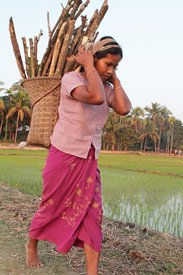bangladesh adivasi story

The Society for Environment and Human Development (SEHD) organized the photography exhibition “Ambushed by Greed: The Chak Story” which was shown from 23 to 29 June 2011. Held at Drik Gallery, the launching of the exhibition was piggybacked with a daylong seminar on the same theme.
In his introductory remarks, Philip Gain, the photographer of the exhibition, explained how the images show an unprecedented ecological disaster that has come along with rubber monoculture, tobacco plantation, and the internal migration of Bangalis.
This has caused hardship and suffering to the Chaks of Bandarban. The Chaks, who number 3,000 in total, are concentrated in 21 villages in Naikhongchhari and Bandarban Sadar upazilas in the Bandarban Hill District. Distinctively different from other ethnic communities in Bangladesh, having a separate language and simple life, this tiny Chak community used to be real forest people, undisturbed and satisfied with their traditional jum agriculture for centuries. But Bangali settlements and the invasion of rubber and tobacco monoculture have opened up the area to the outsiders who have been plundering every natural resource from the Chak land. Consequently, the Chaks are being forced to abandon their homes, land, and traditional agriculture in remote areas.
Gain said that since 2008 he had been trekking through the remote Chak villages, particularly in Baishari Union, only to witness and record some of the devastating effects of rubber monoculture on the high land, and tobacco on the precious bits and pieces of flat land along the streams that the Chaks have used to grow vegetables and other crops.
The exhibition and the seminar were organized to share images and information and to appeal to the state to stop the destruction resulting from the invasion of modern agriculture, internal migration, and ill-conceived development strategies.
Mong Mong Chak, a former official of the Chittagong Hill Tracts Board (CHTB) and a well-known person in the Cha